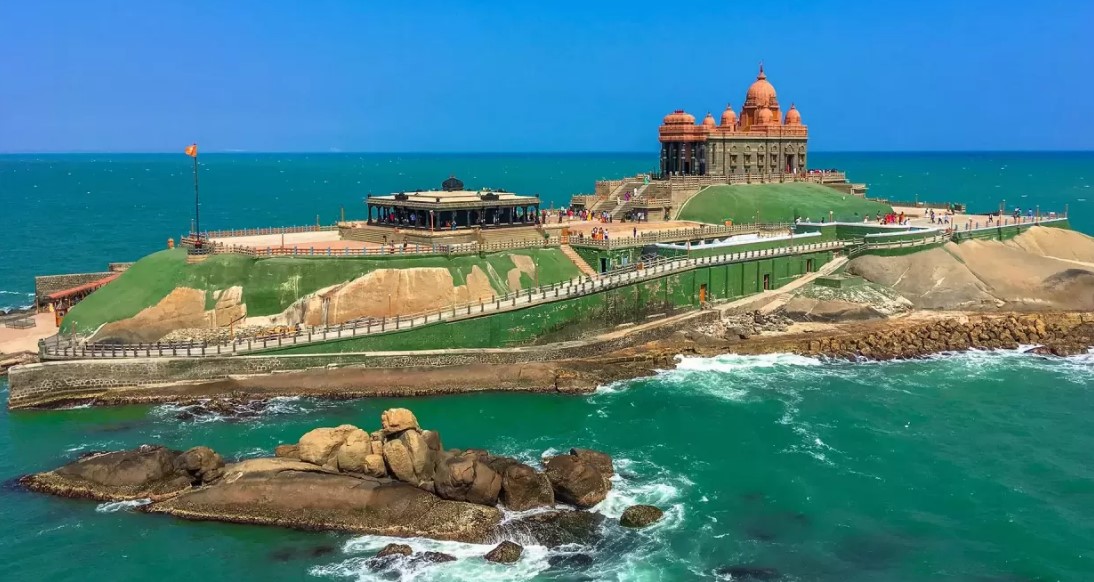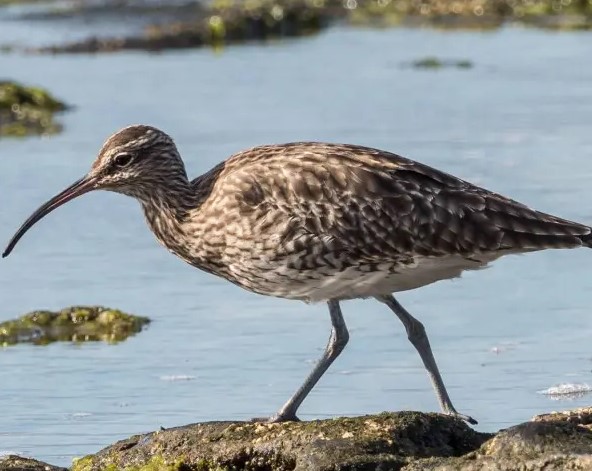Vivekananda Rock
Prime Minister Narendra Modi announced that he will visit and meditate at the Vivekananda Rock Memorial in Kanyakumari.
- Location - The Vivekananda Rock is a tiny rocky islet located near Kanyakumari’s Vavathurai beach, the southern tip of mainland India.
- Confluence of - The rock is surrounded by the Laccadive sea where the Bay of Bengal, the Indian Ocean and the Arabian Sea form a confluence.
- In honour of - The memorial was erected in honour of the great monk, Swamy Vivekananda.
- Inaugurated by - The memorial on the rock was formally inaugurated by the President V V Giri in 1970.
- Mandapams - The Sripada Mandapam and Vivekananda Mandapam are two structures in the memorial.
- There is a life-sized bronze statue of Swami Vivekananda in the premises.

Swamy Vivekananda
- Swami Vivekananda, born Narendranath Datta, was an Indian philosopher, a Hindu monk and a spiritual leader.
- He was born on January 12 in 1863. He belonged to a Bengali family from Kolkata.
- He was a chief disciple of the Indian mystic Sri Ramakrishna Paramahamsa.
- He was a key figure in the introduction of the Indian philosophies of Vedanta and Yoga to the Western world.
- Vivekananda founded the Ramakrishna Math and the Ramakrishna Mission.
- He had a profound vision of Bharat Mata after wandering across the country.
- In 1892, Swami Vivekananda swam from the shores of Kanyakumari to the rocky islet to meditate and attained enlightenment.
- Vivekananda took India’s spiritual fame to the world at the Parliament of World’s Religions held in Chicago in 1893.
- Vivekananda is regarded as a patriotic saint, and his birthday is celebrated as National Youth Day.
- Vivekananda attained mahasamadhi on 4 July, 1902.
Reference
The Indian Express | Vivekananda Rock
World No Tobacco Day
World No Tobacco Day celebrated recently.
- World No Tobacco Day – It is also known as Anti-Tobacco Day, observed annually on May 31st.
- Aim - To raise awareness about the dangers of tobacco consumption and promote tobacco control measures.
- Spearheaded by - World Health Organisation (WHO), originated in 1987 with a resolution titled “World No Smoking Day” to encourage tobacco users to quit.
- Tobacco-free Initiative- In 1998, the WHO established the Tobacco-Free Initiative (TFI) to address the global health challenges posed by tobacco consumption.
- Ban of Tobacco products-The Day advocated for a comprehensive ban on all tobacco products and related advertising to combat the influence of tobacco companies targeting vulnerable populations in 2008.
- Through World No Tobacco Day, the WHO raises awareness about the health risks of tobacco use and advocates for stringent measures to protect public health, especially among youth.
- The ultimate goal is to create a tobacco-free society, free from the harmful impacts of tobacco.
As per WHO, tobacco use is a major cause of death and disease in India, responsible for an estimated 1.35 million deaths annually.
- Theme, 2024 - Protecting Children from Tobacco Industry Interference.
- It focuses on preventing the tobacco industry from targeting young people with harmful products and promoting policies that shield them from manipulative practices.
World Health Organization Framework Convention on Tobacco Control (WHO FCTC)
- Aim - It is a treaty that aims to address the global tobacco epidemic.
- Adopted by - It was adopted by the World Health Assembly in Geneva, Switzerland in 2003.
- Significance - It is one of the most widely ratified treaties in UN history, with 181 countries currently being parties to the convention.
- India’s ratification-India ratified the WHO-Framework Convention on Tobacco Control (WHO-FCTC) in February 2004.
|
National Tobacco Control Programme
|
- Aim - To bring about greater awareness about the harmful effects of tobacco as well as to fulfill the obligations under the WHO-FCTC.
- Launched by - The Ministry of Health and Family Welfare.
- Launched in - 2007- 08.
- The Programme is being implemented in all States/Union Territories.
|
Reference
The Indian Express | World No Tobacco Day
United Nations Military Gender advocate of the year award
Indian peacekeeper Radhika Sen conferred U.N. military gender advocate of the year award for 2023.
- Radhika Sen - The Indian peacekeeper, deployed in United Nations Organization Stabilization Mission in the Democratic Republic of the Congo or MONUSCO, awarded for her work supporting conflict-affected communities.
International day of UN peacekeepers is observed every year on May 30.
Gender advocate of the year award
- Aim - It acknowledges the dedication of an individual military peacekeepers, Created in 2016.
- This award aligns with the principles of UN Security Resolution 1325 on Women, Peace and Security.
- The awardee is selected among candidates nominated by Force Commanders and Heads of Mission from all peace operations.
- India’s Contribution - India is currently the 11th largest contributor of women military peacekeepers to the United Nations with 124 now deployed.
- India has traditionally been among the largest troop and police-contributing countries to UN peacekeeping missions.
- India is the 2nd largest contributor of uniformed personnel to UN Peacekeeping.
References
- The Hindu | Gender advocate of the year award
- Hindustan Times | Radhika Sen a role model
Eurasian Whimbrel
Chhattisgarh recently sighted a GPS-tagged long-distance migratory bird ‘whimbrel’.
- Scientific name - Numenius Phaeopus.
- Family - It is a wader in the large family Scolopacidae.
- Other names - It is also known as the common whimbrel or white-rumped whimbrel.
- Distribution- It is distributed in continents like Antarctica, Europe, North America, Asia, South America, Africa.
- Habitat - The Whimbrel is often found on the intertidal mudflats of sheltered coasts.
- It is also found in harbours, lagoons, estuaries and river deltas, often those with mangroves, but also open, unvegetated mudflats.
- Appearance – It is a fairly large wader, though mid-sized as a member of the curlew genus.
- It is mainly greyish brown, with a white back and rump and a long curved beak with a kink rather than a smooth curve.
- Whimbrel’s call - The usual call is a rippling whistle, prolonged into a trill for the song.
- Conservation Status
o IUCN Red List - Least Concern.

Reference
New Indian Express | Chhattisgarh gets a sighting ‘whimbrel’
Microcephaly
A gene called SASS6 and its variants have been implicated in a developmental process that causes microcephaly
- About - Microcephaly is an uncommon condition whose causes can be genetic or environmental (related to toxicity, radiation or infection).
- It is defined as a condition at birth in which the newborn's head circumference is less than expected for age and sex.
- Symptoms - Many babies born with microcephaly may demonstrate no other symptoms at birth but go on to develop epilepsy, cerebral palsy, learning disabilities, hearing loss and vision problems.
- Types
- Primary or congenital - Baby is born with a smaller head.
- Secondary or acquired - The condition develops as your baby gets older.
- Caused by
- Infections during pregnancy, such as rubella, toxoplasmosis, cytomegalovirus, chickenpox, and possibly the Zika virus
- Severe malnutrition
- Exposure to toxic chemicals
- Genetic or chromosomal abnormalities, such as Down syndrome
- Craniosynostosis, or premature fusing of the skull suture line
Microcephaly is rare. Research estimates it affects about 1 in every 800 to 5,000 babies in the United States.
- Life threatening- Babies with mild microcephaly may not have other problems, but babies with severe microcephaly may have more serious health issues which is life threatening.
- Diagnosis - Microcephaly can be diagnosed by taking a medical and family history, performing a physical exam, measuring the size of the baby's head, and measuring the head size of the parents.
- Treatment - There is no cure for microcephaly, but treatment can focus on managing symptoms and any related conditions.
- Solution - Early intervention with stimulation and play programmes may show positive impacts on development.
References
- The Hindu | Microcephaly
- PAHO | Microcephaly

